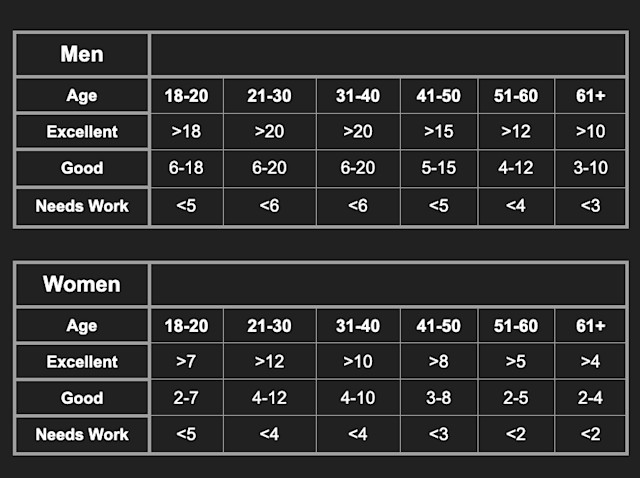Test, maintain, and strengthen your grip, upper body, and lower body.
The Equinox Longevity Assessment is a nine-part series designed to provide members with evidence-based tools to measure and benchmark their fitness age, and provide training guidance to optimize performance. Developed with Michael Crandall, CSCS, a Tier X Coach at Equinox, the full program can be accessed here.
The amount of weight you can deadlift in your 30s and 40s can foreshadow your quality of life decades down the road. As you age, you lose muscle mass and strength, a condition known as sarcopenia. These changes begin as early as your 30s — even if you’re physically active. Research shows muscle mass decreases approximately three to eight percent per decade after age 30 and at higher rates after age 60. Not to mention, you lose muscle strength about two to three times more quickly than you lose muscle mass. A sedentary lifestyle only exacerbates these decrements.
The combination of less muscle and weak muscle might mean you have to give up your golf or pickleball game. But it can also have more serious consequences. If you struggle to perform basic daily functions like standing and walking, you might have to sacrifice living independently, and you also increase your risk of falls and fractures.
Muscle is strongly correlated with living longer. A 10-year observational study of subjects ages 50 and older found that those with low muscle mass were at 40 to 50 percent greater risk of mortality than controls. This study also showed that subjects with low muscle strength were at double the risk of death.
Even if you have an active lifestyle or are a lifelong runner or cyclist, research suggests you still need to invest in strength training to preserve your type II muscle fibers, which are responsible for short, powerful bursts of movement like jumping or sprinting.
The good news: It’s never too late to start strength training. Yes, it takes more time to see gains in your later decades, but if you put in the work, you can still rebuild and maintain muscle. A 2023 study published in the International Journal of Sport Nutrition and Exercise Metabolism found that even people in their 80s and 90s who hadn’t weight trained previously saw improvements after 12 weeks of progressive, full-body resistance training.
The following four tests measure maximal strength (the heaviest amount of weight you can lift while maintaining proper form in a short period of time) for your grip, upper body, and lower body. Your scores will give you insights into whether you have more upper body or lower body strength. With help from existing research, Crandall developed the following norms charts that you can use to see how you stack up against other people of your sex and age. Use these tests as benchmarks for improvement throughout the years.
Test 1. Grip Strength: Bottom Position Static Hang for Time

A strong grip is a great proxy for longevity, which makes the amount of weight you can carry one of the most meaningful measures of strength. Research links better grip strength in midlife and beyond to decreased risk of overall mortality.
Tip: Perform a dead hang from a pull-up bar with an overhand grip and straight arms. Hold the exercise for as long as possible.
• Less than 30 seconds = needs work
• 30 to 60 seconds = good, but could improve
• Greater than 60 seconds = great
Test 2. Lower-Body Strength: Selectorized Seated Leg Extension 1-Rep Max

Tip: As you exhale, drive your feet toward the ceiling to fully extend your legs. The goal is to perform one full rep of your body weight on the Club’s leg extension machine so that your legs are fully straight at extension.
• If under that = needs work
• If over = great
Test 3. Upper-Body Strength: Push-Up to Failure

Tests three and four underscore why bodyweight:strength ratio is so important, according to Michael Crandall, CSCS, a Tier X Coach at E by Equinox - Hudson Yards. “These tests measure how well you can move your body weight, which becomes critical as we age,” he says. “A 175-pound man with exceptional strength will perform better at these tests than a 250-pound man with the same strength.”
Crandall adds: “Push-ups and pull-ups can be a test of muscular endurance or strength. If you are in the ‘needs work’ category you most likely have upper body strength that needs improvement or a discrepancy in bodyweight:strength ratio. Once you perform past the ‘needs work’ category, you are assessing muscular endurance.”
Tip: Lower until your arms are bent past 90 degrees. You can place a yoga block on its lowest height beneath your sternum to ensure you are lowering down far enough.

Test 4. Upper-Body and Grip Strength: Neutral Grip Pull-Up to Failure

Tip: Your elbows should straighten every time you lower.

Action Plan
As long as the weight on an exercise is heavy enough to increase the difficulty to six reps or less, you are working to build strength, says Crandall. He recommends the following strength exercises. There are variations of each exercise to accommodate every individual. Any Equinox trainer on the floor can help you select what’s best for you.
• Deadlifts to improve lower-body and back strength
• Neutral grip pull-ups to improve upper-body and arm strength
• Barbell or dumbbell bench press to improve upper-body strength
• Barbell front squat or back squat to improve lower-body strength
• Seated neutral grip cable pulldown to improve upper-body strength
